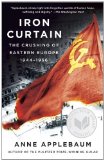Summary | Excerpt | Reviews | Beyond the Book | Readalikes | Genres & Themes | Author Bio

Critics' Opinion:
Readers' Opinion:
First Published:
Oct 2012, 608 pages
Paperback:
Aug 2013, 640 pages
 Book Reviewed by:
Book Reviewed by:
Kim Kovacs
Buy This Book
Yet as Part One of this book will explain, the Soviet Union did import certain key elements of the Soviet system into every nation occupied by the Red Army, from the very beginning. First and foremost, the Soviet NKVD , in collaboration with local communist parties, immediately created a secret police force in its own image, often using people whom they had already trained in Moscow. Everywhere the Red Army went – even in Czechoslovakia, from which Soviet troops eventually withdrew – these newly minted secret policemen immediately began to use selective violence, carefully targeting their political enemies according to previously composed lists and criteria. In some cases, they targeted enemy ethnic groups as well. They also took control of the region's Interior Ministries, and in some cases the Defence Ministries as well, and participated in the immediate confiscation and redistribution of land.
Secondly, in every occupied nation, Soviet authorities placed trusted local communists in charge of the era's most powerful form of mass media: the radio. Although it was possible, in most of Eastern Europe, to publish non-communist newspapers or magazines in the initial months after the war, and although non-communists were allowed to run other state monopolies, the national radio stations, which could reach everyone from illiterate peasants to sophisticated intellectuals, were kept under fi rm communist party control. In the long term, the authorities hoped that the radio, together with other propaganda and changes to the educational system, would help bring mass numbers of people into the communist camp. Thirdly, everywhere the Red Army went, Soviet and local communists harassed, persecuted and eventually banned many of the independent organizations of what we would now call civil society: the Polish Women's League, the German 'anti-fascist' groupings, church groups and schools. In particular, they were fixated, from the very first days of the occupation, on youth groups: young social democrats, young Catholic or Protestant organizations, boy scouts and girl scouts. Even before they banned independent political parties for adults, and even before they outlawed church organizations and independent trade unions, they put young people's organizations under the strictest possible observation and restraint.
Finally, wherever it was possible, Soviet authorities, again in conjunction with local communist parties, carried out policies of mass ethnic cleansing, displacing millions of Germans, Poles, Ukrainians, Hungarians and others from towns and villages where they had lived for centuries. Trucks and trains moved people and a few scant possessions into refugee camps and new homes hundreds of miles away from where they had been born. Disoriented and displaced, the refugees were easier to manipulate and control than they might have been otherwise. To some degree, the United States and Britain were complicit in this policy – ethnic cleansing of the Germans would be written into the Potsdam treaty – but few in the West understood at the time how extensive and violent Soviet ethnic cleansing would turn out to be.
Other elements of capitalism and even liberalism did remain in place for a time. Private farming, private business and private trade persisted throughout 1945 and 1946 , and sometimes longer. Some independent newspapers and journals kept publishing and some churches remained open. In some places, non-communist political parties were also allowed to function, along with selected noncommunist politicians. But this is not because the Soviet communists and their Eastern European allies were liberal-minded democrats. This is because they thought that these things were less important, in the short term, than the secret police, the radio, ethnic cleansing, and the domination of youth groups and other civic organizations. It was not a coincidence that ambitious young communists invariably went to work in one of these areas. Upon joining the party in 1945 , the communist writer Wiktor Woroszylski was offered three choices: the communist youth movement, the secret police and the propaganda department, which dealt with mass media.
Excerpted from Iron Curtain by Anne Applebaum. Copyright © 2012 by Anne Applebaum. Excerpted by permission of Doubleday. All rights reserved. No part of this excerpt may be reproduced or reprinted without permission in writing from the publisher.





The Funeral Cryer by Wenyan Lu
Debut novelist Wenyan Lu brings us this witty yet profound story about one woman's midlife reawakening in contemporary rural China.
Your guide toexceptional books
BookBrowse seeks out and recommends the best in contemporary fiction and nonfiction—books that not only engage and entertain but also deepen our understanding of ourselves and the world around us.